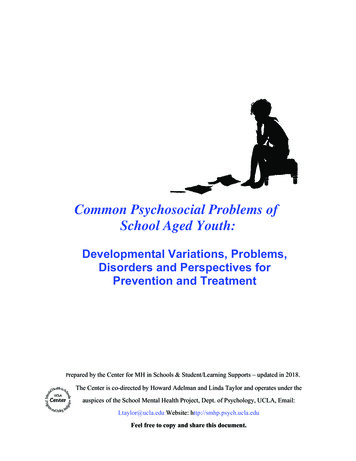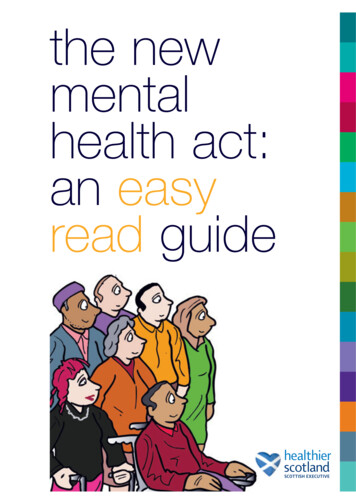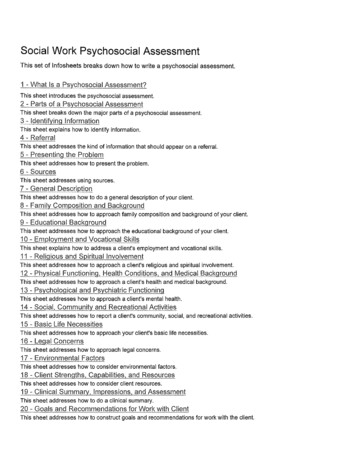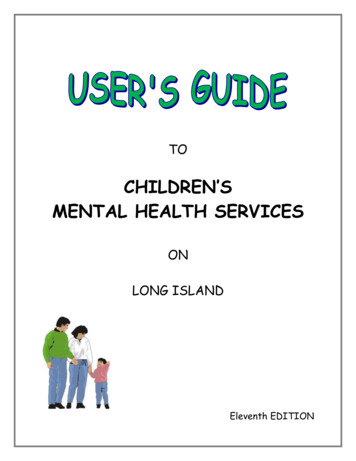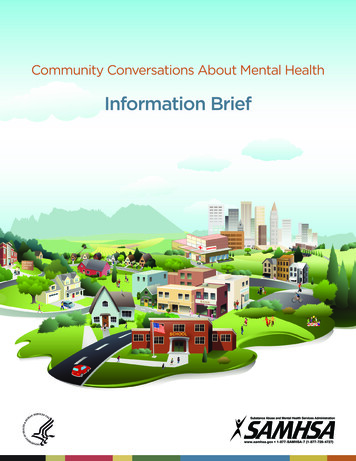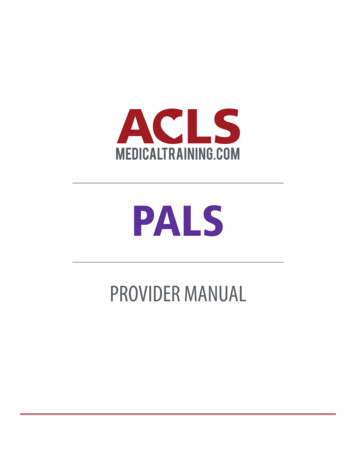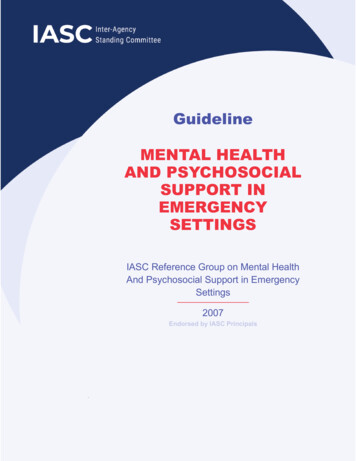
Transcription
GuidelineMENTAL HEALTHAND PSYCHOSOCIALSUPPORT INEMERGENCYSETTINGSIASC Reference Group on Mental HealthAnd Psychosocial Support in EmergencySettings2007Endorsed by IASC Principals
Support in Emergency Settings reflect the insights of numerousagencies and practitioners worldwide and provide valuableinformation to organisations and individuals on how to respondappropriately during humanitarian emergencies.Specific action sheets offer useful guidance on mental health andpsychosocial support, and cover the following areas:CoordinationAssessment, Monitoring and EvaluationProtection and Human Rights StandardsHuman ResourcesCommunity Mobilisation and SupportHealth ServicesEducationDissemination of InformationFood Security and NutritionShelter and Site PlanningWater and SanitationThe Guidelines include a matrix, with guidance for emergency planning,actions to be taken in the early stages of an emergency and comprehensiveresponses needed in the recovery and rehabilitation phases. The matrixis a valuable tool for use in coordination, collaboration and advocacyefforts. It provides a framework for mapping the extent to which essentialfirst responses are being implemented during an emergency.The Guidelines include a companion CD-ROM, which contains the fullGuidelines and also resource documents in electronic format.Published by the Inter-Agency Standing Committee (IASC), the Guidelinesgive humanitarian actors useful inter-agency, inter-sectoral guidance andtools for responding effectively in the midst of emergencies.ISBN 978-1-4243-3444-5Iasc Guidelines on Mental Health and Psychosocial Support in Emergency SettingsThe IASC Guidelines for Mental Health and PsychosocialIasc Guidelineson Mental Health andPsychosocial Supportin Emergency Settings
Iasc Guidelineson Mental Healthand Psychosocial Supportin Emergency Settings
Foreword Inter-Agency Standing Committee 2007The Inter-Agency Standing Committee (IASC) issues these Guidelines to enableThe Inter-Agency Standing Committee (IASC) was established in 1992 in response to Generalhumanitarian actors to plan, establish and coordinate a set of minimum multi-sectoralAssembly Resolution 46/182, which called for strengthened coordination of humanitarian assistance.responses to protect and improve people’s mental health and psychosocial well-beingThe resolution set up the IASC as the primary mechanism for facilitating inter-agency decision-makingin the midst of an emergency.in response to complex emergencies and natural disasters. The IASC is formed by the heads of a broadPopulations affected by emergencies frequently experience enormous suffering.range of UN and non-UN humanitarian organisations. For further information on the IASC, pleaseaccess its website at: http://www.humanitarianinfo.org/iascThis IASC publication will be available in different languages and can be obtained from the IASCwebsite at: ctsCover page photos: International Rescue CommitteeSuggested citation:Inter-Agency Standing Committee (IASC) (2007). IASC Guidelines on Mental Health and PsychosocialSupport in Emergency Settings. Geneva: IASC.For feedback or suggestions for the improvement of this publication, please e-mail:IASCmhpss@who.int or IASCmhpss@interaction.org.Humanitarian actors are increasingly active to protect and improve people’s mentalhealth and psychosocial well-being during and after emergencies. A significant gap,however, has been the absence of a multi-sectoral, inter-agency framework that enableseffective coordination, identifies useful practices, flags potentially harmful practicesand clarifies how different approaches to mental health and psychosocial supportcomplement one another.The Guidelines offer essential advice on how to facilitate an integratedapproach to address the most urgent mental health and psychosocial issues inemergency situations.I would like to thank the members of the IASC Task Force on Mental Healthand Psychosocial Support in Emergency Settings and specifically the Task Forceco-chairs, WHO and InterAction, for achieving inter-agency consensus on minimumresponses in this important area of humanitarian aid.I call upon all those who are involved in humanitarian assistance to implementthese Guidelines.Kasidis RochanakornChair, Inter-Agency Standing Committee Working GroupDirector, OCHA Genevaiiiasc Guidelines on Mental Health and Psychosocial Support in Emergency SettingsAcknowledgementsiii
AcknowledgementsThe Inter-Agency Standing Committee Médicos del Mundo (MdM-Spain)The Task Force is grateful for commentsGoa; South African Institute forTask Force on Mental Health and Médecins Sans Frontières Hollandon earlier versions of the matrix and/orTraumatic Stress; STEPS Consultingselected Action Sheets by individualSocial; Tanganyika Christian Refugeereviewers affiliated with the followingService; Terre des Hommesorganisations:Foundation; The Foundation forPsychosocial Support in EmergencySettings wishes to thank everybody whohas collaborated on the developmentof these guidelines. Special thanks tothe following agencies who are membersof the Task Force and whose staff havedeveloped these guidelines:(MSF-Holland) Oxfam GB Refugees Education Trust (RET) Save the Children UK (SC-UK)International Federation of Red Crossand Red Crescent Societies (IFRC)International Organization forAction Contre la Faim (ACF)InterAction (co-chair), through: American Red Cross (ARC) Christian Children’s Fund (CCF) International Catholic MigrationCommission (ICMC) International Medical Corps (IMC) International Rescue Committee(IRC) Mercy Corps Save the Children USA (SC-USA)International Council of VoluntaryAgencies (ICVA), through: ActionAid Internationaliv NGOs: Aga Khan DevelopmentCrescent Society; War Child Holland.Network; Antares Foundation;Austrian Red Cross; BasicNeeds; Universities: Birzeit University WestCARE USA; Child Fund Afghanistan;Bank; Boston University; ColumbiaChurch of Sweden Aid; ChurchUniversity; Harvard University;World Service; Community andJohns Hopkins University; KarolinskaFamily Services International; EnfantsInstitutet; Kent State University; King’sRéfugiés du Monde; FundaciónCollege; London School of HygieneDos Mundos; Global Psycho-Socialand Tropical Medicine; NorthumbriaInitiatives; Handicap International;University; Pomona College; San JoseHeadington Institute; Human RightsState University; State University ofWatch; Impact Foundation;New York; Uniformed ServicesUnited Nations Population Fund (UNFPA)International Critical Incident StressUniversity of the Health Sciences;World Food Programme (WFP)Foundation; InternationalUniversity of Colombo; UniversityWorld Health Organization (WHO)Rehabilitation Council for Tortureof Geneva; University of Jaffna;Victims; Jesuit Refugee Service;University of Lund; University ofMédecins Sans Frontières Switzerland;Maryland; University of Melbourne;Médecins Sans Frontières Spain;University of New South Wales;Norwegian Refugee Council;University of Oxford; UniversityPalestinian Red Crescent Society;of Pennsylvania; University of SouthPeople in Aid; Programa PsicosocialDakota; University of Western Sydney;en Chiapas; Psychologues du Monde;University of the Philippines;PULIH Foundation Indonesia;Victoria University; Vrije UniversiteitRefugees International; Sangath CentreAmsterdam; Wageningen University.Migration (IOM)Office for the Coordination ofHumanitarian Affairs (OCHA)United Nations Children’s Fund(UNICEF)United Nations High Commissionerfor Refugees (UNHCR)(co-chair)Inter-Agency Network for Educationin Emergencies (INEE)Children and War; Turkish RedThe WHO Department of Mental Healthand Substance Abuse (through fundsfrom the Government of Italy) and theChristian Children’s Fund are gratefullyacknowledged for making available CARE Austriasubstantial staff member time towards HealthNet-TPOfacilitating the project.iasc Guidelines on Mental Health and Psychosocial Support in Emergency SettingsAcknowledgementsv
Table of contentsIntervention: International JournalForewordiiigovernment agencies, consortia,of Mental Health, Psychosocial WorkAcknowledgementsivnetworks): American Psychiatricand Counselling in AreasChapter 1. Introduction1Association; American Psychologicalof Armed Conflict; MangroveBackground1Association; Asian Harm ReductionPsychosocial Support andNetwork; Canadian Forces MentalCoordination Unit; Ministry of Health,Mental health and psychosocial impact of emergencies2Health Services; Cellule d’UrgenceIran; Ministry of Health, Sri Lanka;The guidelines5Médico-Psychologique – SAMU dePsychologists for Social Responsibility;How to use this document7Paris; Centre Hospitalier Saint-Anne;Psychosocial Working Group; RegionalCore principles9Centers for Disease Control andPsychosocial Support Initiative forPrevention (CDC); Consortium ofChildren Affected by AIDS, PovertyHumanitarian Agencies Sri Lanka;and Conflict (REPSSI); United NationsConsultative Group on EarlyEducational, Scientific and Cultural Others (e.g. professional associations,16Chapter 2. Matrix of Interventions20Chapter 3. Action Sheets for Minimum Response30Childhood Care and Development;Organization (UNESCO); UnitedDepartment of Human Services,States Agency for International1.1: Establish coordination of intersectoral mental health andMelbourne; European Federation ofDevelopment; World Associationpsychosocial supportPsychologists’ Associations; Food andfor Psychosocial Rehabilitation;Agriculture Organization of the UnitedWorld Federation for Mental Health;Nations (FAO); Hellenic Centre ofWorld Federation of OccupationalMental Health; IASC Early RecoveryTherapists; World PsychiatricCluster; IASC Health Cluster; IASCAssociation.Camp Coordination and CampManagement Cluster; IberoamericanEco-Bioethics Network for Education,Science and Technology; InternationalAlliance for Child and AdolescentMental Health and Schools;International Association for Childand Adolescent Psychiatry andviFrequently asked questionsCoordination33Assessment, monitoring and evaluation2.1: Conduct assessments of mental health and psychosocial issues382.2: Initiate participatory systems for monitoring and evaluation46Protection and human rights standards3.1: Apply a human rights framework through mental health andThe Task Force thanks the Internationalpsychosocial supportRescue Commitee and the Terre des3.2: Identify, monitor, prevent and respond to protection threats andHommes Foundation for organizingfailures through social protectionthe printing and the IASC Health3.3: Identify, monitor, prevent and respond to protection threatsCluster, UNICEF, UNHCR, and IFRC forand abuses through legal protectionfunding the printing of these Guidelines.5664Human resourcesAllied Professions; International4.1: Identify and recruit staff and engage volunteers whoSociety for Traumatic Stress Studies;understand local cultureiasc Guidelines on Mental Health and Psychosocial Support in Emergency Settings5071Table of contentsvii
4.2: Enforce staff codes of conduct and ethical guidelines764.3: Organise orientation and training of aid workers in mental healthand psychosocial support9.1: Include specific social and psychological considerations (safe aidfor all in dignity, considering cultural practices and household roles)87Community mobilisation and supportin the provision of food and nutritional support168Shelter and site planning5.1: Facilitate conditions for community mobilisation, ownership10.1: Include specific social considerations (safe, dignified, culturallyand control of emergency response in all sectors93and socially appropriate assistance) in site planning and shelter5.2: Facilitate community self-help and social support100provision, in a coordinated manner5.3: Facilitate conditions for appropriate communal cultural,spiritual and religious healing practices163Food security and nutrition814.4: Prevent and manage problems in mental health and psychosocialwell-being among staff and volunteers8.2: Provide access to information about positive coping methods174Water and sanitation10611.1: Include specific social considerations (safe and culturally5.4: Facilitate support for young children (0–8 years) and theirappropriate access for all in dignity) in the provision of watercare-givers110and sanitation179Health services6.1: Include specific psychological and social considerations inprovision of general health care1166.2: Provide access to care for people with severe mental disorders1236.3: Protect and care for people with severe mental disorders and othermental and neurological disabilities living in institutions1326.4: Learn about and, where appropriate, collaborate with local,indigenous and traditional health systems1366.5: Minimise harm related to alcohol and other substance use142Education7.1: Strengthen access to safe and supportive education148Dissemination of information8.1: Provide information to the affected population on the emergency,relief efforts and their legal rightsviiiiasc Guidelines on Mental Health and Psychosocial Support in Emergency Settings157Table of contentsix
BackgroundArmed conflicts and natural disasters cause significant psychological and socialsuffering to affected populations. The psychological and social impacts of emergenciesmay be acute in the short term, but they can also undermine the long-term mentalhealth and psychosocial well-being of the affected population. These impacts maythreaten peace, human rights and development. One of the priorities in emergenciesis thus to protect and improve people’s mental health and psychosocial well-being.Achieving this priority requires coordinated action among all government and nongovernment humanitarian actors.A significant gap, however, has been the absence of a multi-sectoral, inter-Ch a pter 1Introductionagency framework that enables effective coordination, identifies useful practices andflags potentially harmful practices, and clarifies how different approaches to mentalhealth and psychosocial support complement one another. This document aims to fillthat gap.These guidelines reflect the insights of practitioners from different geographicregions, disciplines and sectors, and reflect an emerging consensus on good practiceamong practitioners. The core idea behind them is that, in the early phase of anemergency, social supports are essential to protect and support mental health andpsychosocial well-being. In addition, the guidelines recommend selected psychologicaland psychiatric interventions for specific problems.The composite term mental health and psychosocial support is used in thisdocument to describe any type of local or outside support that aims to protect orpromote psychosocial well-being and/or prevent or treat mental disorder. Althoughthe terms mental health and psychosocial support are closely related and overlap,for many aid workers they reflect different, yet complementary, approaches.Aid agencies outside the health sector tend to speak of supporting psychosocialwell-being. Health sector agencies tend to speak of mental health, yet historically havealso used the terms psychosocial rehabilitation and psychosocial treatment todescribe non-biological interventions for people with mental disorders. Exactdefinitions of these terms vary between and within aid organisations, disciplines andcountries. As the current document covers intersectoral, inter-agency guidelines, thecomposite term mental health and psychosocial support (MHPSS) serves to unite asIntroduction1
broad a group of actors as possible and underscores the need for diverse,complementary approaches in providing appropriate supports. Humanitarian aid-related problems (e.g. anxiety due to a lack of informationabout food distribution).Scientific evidence regarding the mental health and psychosocial supports thatThus, mental health and psychosocial problems in emergencies encompass far moreprove most effective in emergency settings is still thin. Most research in this area hasthan the experience of PTSD.been conducted months or years after the end of the acute emergency phase. As thisemerging field develops, the research base will grow, as will the base of practitioners’field experience. To incorporate emerging insights, this publication should be updatedperiodically.People at increased risk of problemsIn emergencies, not everyone has or develops significant psychological problems.Many people show resilience, that is the ability to cope relatively well in situations ofadversity. There are numerous interacting social, psychological and biological factorsMental health and psychosocial impactof emergenciesProblemsEmergencies create a wide range of problems experienced at the individual, family,community and societal levels. At every level, emergencies erode normally protectivesupports, increase the risks of diverse problems and tend to amplify pre-existingproblems of social injustice and inequality. For example, natural disasters such asfloods typically have a disproportionate impact on poor people, who may be livingin relatively dangerous places.Mental health and psychosocial problems in emergencies are highly interconnected, yet may be predominantly social or psychological in nature. Significantproblems of a predominantly social nature include:the face of adversity.Depending on the emergency context, particular groups of people are atincreased risk of experiencing social and/or psychological problems. Although manykey forms of support should be available to the emergency-affected population ingeneral, good programming specifically includes the provision of relevant supportsto the people at greatest risk, who need to be identified for each specific crisis (seeChapter 3, Action Sheet 2.1).All sub-groups of a population can potentially be at risk, depending on thenature of the crisis. The following are groups of people who frequently have beenshown to be at increased risk of various problems in diverse emergencies: Women (e.g. pregnant women, mothers, single mothers, widows and, in somecultures, unmarried adult women and teenage girls); Pre-existing (pre-emergency) social problems (e.g. extreme poverty; belonging Men (e.g. ex-combatants, idle men who have lost the means to take care of theirto a group that is discriminated against or marginalised; political oppression);families, young men at risk of detention, abduction or being targets of violence); Emergency-induced social problems (e.g. family separation; disruption of social Children (from newborn infants to young people 18 years of age), such asnetworks; destruction of community structures, resources and trust; increasedseparated or unaccompanied children (including orphans), children recruitedgender-based violence); andor used by armed forces or groups, trafficked children, children in conflict with Humanitarian aid-induced social problems (e.g. undermining of communitystructures or traditional support mechanisms).Similarly, problems of a predominantly psychological nature include: Pre-existing problems (e.g. severe mental disorder; alcohol abuse); Emergency-induced problems (e.g. grief, non-pathological distress; depressionand anxiety disorders, including post-traumatic stress disorder (PTSD)); and2that influence whether people develop psychological problems or exhibit resilience iniasc Guidelines on Mental Health and Psychosocial Support in Emergency Settingsthe law, children engaged in dangerous labour, children who live or work onthe streets and undernourished/understimulated children; Elderly people (especially when they have lost family members who werecare-givers); Extremely poor people; Refugees, internally displaced persons (IDPs) and migrants in irregular situationsIntroduction3
(especially trafficked women and children without identification papers); People who have been exposed to extremely stressful events/trauma (e.g. peoplecommon error in work on mental health and psychosocial well-being is to ignore theseresources and to focus solely on deficits – the weaknesses, suffering and pathology –who have lost close family members or their entire livelihoods, rape and tortureof the affected group.survivors, witnesses of atrocities, etc.);Affected individuals have resources such as skills in problem-solving, People in the community with pre-existing, severe physical, neurological ormental disabilities or disorders; People in institutions (orphans, elderly people, people with neurological/mentaldisabilities or disorders); People experiencing severe social stigma (e.g. untouchables/dalit, commercial sexcommunication, negotiation and earning a living. Examples of potentially supportivesocial resources include families, local government officers, community leaders,traditional healers (in many societies), community health workers, teachers, women’sgroups, youth clubs and community planning groups, among many others. Affectedcommunities may have economic resources such as savings, land, crops and animals;educational resources such as schools and teachers; and health resources such asworkers, people with severe mental disorders, survivors of sexual violence);health posts and staff. Significant religious and spiritual resources include religious People at specific risk of human rights violations (e.g. political activists, ethnicleaders, local healers, practices of prayer and worship, and cultural practices suchor linguistic minorities, people in institutions or detention, people alreadyas burial rites.exposed to human rights violations).To plan an appropriate emergency response, it is important to know theIt is important to recognise that: There is large diversity of risks, problems and resources within and acrosseach of the groups mentioned above.nature of local resources, whether they are helpful or harmful, and the extent to whichaffected people can access them. Indeed, some local practices – ranging from particulartraditional cultural practices to care in many existing custodial institutions – may beharmful and may violate human rights principles (see Action Sheets 5.3, 6.3 and 6.4). Some individuals within an at-risk group may fare relatively well. Some groups (e.g. combatants) may be simultaneously at increased risk ofsome problems (e.g. substance abuse) and at reduced risk of other problemsThe guidelines(e.g. starvation). Some groups may be at risk in one emergency, while being relatively privilegedin another emergency. Where one group is at risk, other groups are often at risk as well (SphereProject, 2004).To identify people as ‘at risk’ is not to suggest that they are passive victims. Althoughat-risk people need support, they often have capacities and social networks that enablethem to contribute to their families and to be active in social, religious and political life.Purpose of these guidelinesThe primary purpose of these guidelines is to enable humanitarian actors andcommunities to plan, establish and coordinate a set of minimum multi-sectoralresponses to protect and improve people’s mental health and psychosocial well-beingin the midst of an emergency. The focus of the guidelines is on implementing minimumresponses, which are essential, high-priority responses that should be implemented assoon as possible in an emergency. Minimum responses are the first things that ought tobe done; they are the essential first steps that lay the foundation for the morecomprehensive efforts that may be needed (including during the stabilised phase and4Resourcesearly reconstruction).Affected groups have assets or resources that support mental health and psychosocialTo complement the focus on minimum response, the guidelines also listwell-being. The nature and extent of the resources available and accessible may varyconcrete strategies for mental health and psychosocial support to be considered mainlywith age, gender, the socio-cultural context and the emergency environment. Abefore and after the acute emergency phase. These ‘before’ (emergency preparedness)iasc Guidelines on Mental Health and Psychosocial Support in Emergency SettingsIntroduction5
and ‘after’ (comprehensive response) steps establish a context for the minimumAn overview of the guidelinesresponse and emphasise that the minimum response is only the starting point for moreThe structure of these IASC Guidelines is consistent with two previous IASCcomprehensive supports (see Chapter 2).documents: the Guidelines for HIV/AIDS Interventions in Emergency SettingsAlthough the guidelines have been written for low- and middle-income(IASC, 2003) and the Guidelines on Gender-Based Violence Interventions incountries (where Inter-Agency Standing Committee (IASC) member agencies tend toHumanitarian Settings (IASC, 2005). All three of these IASC documents includework), the overall framework and many parts of the guidelines apply also to large-a matrix, which details actions for various actors during different stages ofscale emergencies in high-income countries.emergencies, and a set of action sheets that explain how to implement minimumresponse items identified in the middle column (Minimum Response) of the matrix.Target audienceThese guidelines were designed for use by all humanitarian actors, includingcommunity-based organisations, government authorities, United Nationsorganisations, non-government organisations (NGOs) and donors operating inThe current guidelines contain 25 such action sheets (see Chapter 3).The matrix (displayed in Chapter 2) provides an overview of recommendedkey interventions and supports for protecting and improving mental health andpsychosocial well-being. The three matrix columns outline the:emergency settings at local, national and international levels. Emergency preparedness steps to be taken before emergencies occur;The orientation of these guidelines is not towards individual agencies or Minimum responses to be implemented during the acute phase of the emergency;projects. Implementation of the guidelines requires extensive collaboration amongvarious humanitarian actors: no single community or agency is expected to have thecapacity to implement all necessary minimum responses in the midst of an emergency.The guidelines should be accessible to all humanitarian actors to organisecollaboratively the necessary supports. Of particular importance is the activeinvolvement at every stage of communities and local authorities, whose participationis essential for successful, coordinated action, the enhancement of local capacitiesand sustainability. To maximise the engagement of local actors, the guidelines shouldbe translated into the relevant local language(s).These guidelines are not intended solely for mental health and psychosocialworkers. Numerous action sheets in the guidelines outline social supports relevantto the core humanitarian domains, such as disaster management, human rights,protection, general health, education, water and sanitation, food security andand Comprehensive responses to be implemented once the minimum responses havebeen implemented. Typically, this is during the stabilised and early reconstructionphases of the emergency.The action sheets emphasise the importance of multi-sectoral, coordinated action.Each action sheet therefore includes (hyper-)links, indicated by turquoise text, relatingto action sheets in other domains/sectors.Each action sheet consists of a rationale/background; descriptions of keyactions; selected sample process indicators; an example of good practice in previousemergencies; and a list of resource materials for further information. Almost all listedresource materials are available via the internet and are also included in theaccompanying CD-ROM.nutrition, shelter, camp management, community development and masscommunication. Mental health professionals seldom work in these domains, butare encouraged to use this document to advocate with communities and colleaguesfrom other disciplines to ensure that appropriate action is taken to address theHow to use this documentsocial risk factors that affect mental health and psychosocial well-being. However,6the clinical and specialised forms of psychological or psychiatric supports indicatedReading the document from cover to cover may not be possible during an emergency.in the guidelines should only be implemented under the leadership of mental healthIt may be read selectively, focusing on items that have the greatest relevance to theprofessionals.reader’s responsibilities or capacities. A good way to begin is to read the matrix,iasc Guidelines on Mental Health and Psychosocial Support in Emergency SettingsIntroduction7
focusing on the centre column of minimum response, look for the items of greatestnon-participatory sectoral programmes are being established, the guidelines couldrelevance and go directly to the corresponding action sheets. It is important tobe used to make the case with different stakeholders for why a more participatoryremember that no single agency is expected to implement every item in the guidelines.approach would be beneficial. Similarly, if very young children are at risk andThe guidelines aim to strengthen the humanitarian response in emergencies byreceiving no support, Action Sheet 5.4 could be used to advocate for the establishmentall actors, from pre-emergency preparedness through all steps of response programmeof appropriate early child development supports.planning, implementation and evaluation. They are especially useful as a tool forWorking with partners to develop appropriate mental health and psychosocialstrengthening coordination and advocacy.supports is an important part of advocacy. Dialogue with partners, whether NGO,government or UN staff, may help steer them, where needed, toward the kinds ofCoordinationpractices outlined in this document. The guidelines may also be used for advocacy inIn emergencies, coordination of aid is one of the most important and most chal
tools for responding effectively in the midst of emergencies. ISBN 978-1-4243-3444-5 The IASC Guidelines for Mental Health and Psychosocial Support in Emergency Settings reflect the insights of numerous agencies and practitioners worldwide and provide valuable information to organisations and individuals on how to respond

